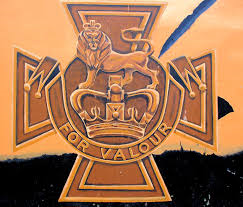
Double ceremony in Moray to honour WW1 VCs
Two Moray soldiers awarded the country’s highest military honour during the First World War are to be commemorated at ceremonies in their home towns later this year.
By remarkable coincidence, Pte George McIntosh and Sgt Alexander Edwards won the Victoria Cross within hours of each other during the Battle of Passchendaele in 1917.
In their honour, commemorative stones commissioned by the UK Government will be laid to coincide – almost exactly to the day - with the centenary of the heroic deeds which earned them a place in military history.
A stone bearing Pte McIntosh’s name will be placed next to the war memorial in Buckie on Saturday, July 29 as part of an event being staged by the Gordon Highlanders’ Association.
And the following day a stone will be unveiled in memory of Sgt Edwards at the war memorial in Lossiemouth where he was born and raised.
It was on July 31, 1917 – and, in the case of Sgt Edwards, also August 1 – that they displayed outstanding courage as the bloody Battle of Passchendaele got under way.
While Pte McIntosh survived the war and lived until he was 63, Sgt Edwards was killed in action in 1918 at the age of 32.
To mark the centenary of the First World War, the government embarked on a campaign to commemorate all 627 service personnel who were awarded the Victoria Cross during the conflict by having an engraved paving stone laid in their home town.
Moray produced no fewer than five VC recipients, three of whom – Lt Cmmdr Martin Dunbar-Nasmith from Rothes; Sgt John Ripley from Keith and Cpl William Anderson from Dallas - have already been honoured.
George McIntosh was just 20 years old and a private in the Gordon Highlanders when he single-handedly neutralised an enemy position while he and other members of his company were under heavy fire.
He went on to serve in the RAF during World War Two and was janitor at Buckie High School until his death in 1960. He is buried in Buckie’s west cemetery.
Alexander Edwards was the son of a fisherman and joined up at the outbreak of the war. He was a company sergeant major in the Seaforth Highlanders when, on consecutive days and despite suffering bullet and shrapnel wounds, he knocked out an enemy position and rescued an officer as he lay badly wounded in no man’s land.
Edwards was reported missing in action in March of the following year and his body was never found.
He is commemorated on the Arras Memorial and on the Lossiemouth war memorial. There are also memorials at Lodge Pitgavey in Lossiemouth, of which he was a member, and at Moray Golf Club where he caddied as a boy.
Moray Council area stretches from Tomintoul in the south to the shores of the Moray Firth, from Keith in the east to Forres in the west. The council and its 4,500 employees respond to the needs of 95,510 residents in this beautiful part of Scotland, which nestles between Aberdeenshire and the Highlands.
Famous for its colony of dolphins, fabulous beaches and more malt whisky distilleries than any where else in Scotland, Moray is a thriving area and a great place to live.
Headquartered in Elgin, the administrative capital of Moray.
